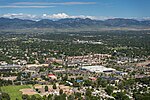Rocky Flats Plant

The Rocky Flats Plant was a U.S. manufacturing complex that produced nuclear weapons parts in the western United States, near Denver, Colorado. The facility's primary mission was the fabrication of plutonium pits, which were shipped to other facilities to be assembled into nuclear weapons. Operated from 1952 to 1992, the complex was under the control of the U.S. Atomic Energy Commission (AEC), succeeded by the Department of Energy (DOE) in 1977. Plutonium pit production was halted in 1989 after EPA and FBI agents raided the facility and the plant was formally shut down in 1992. Operators of the plant (Rockwell) later pled guilty to criminal violations of environmental law. At the time, the fine was one of the largest penalties ever in an environmental law case.Cleanup began in the early 1990s, and the site achieved regulatory closure in 2006. The cleanup effort decommissioned and demolished over 800 structures; removed over 21 tons of weapons-grade material; removed over 1.3 million cubic meters of waste; and treated more than 16 million US gallons (61,000 m3) of water. Four groundwater treatment systems were also constructed. Today, the Rocky Flats Plant is gone. The site of the former facility consists of two distinct areas: (1) the "Central Operable Unit" (including the former industrial area), which remains off-limits to the public as a CERCLA "Superfund" site, owned and managed by the U.S. Department of Energy, and (2) the Rocky Flats National Wildlife Refuge, owned and managed by the U.S. Fish and Wildlife Service. The Refuge (also known as the "Peripheral Operable Unit") was determined to be suitable for unrestricted use. Every five years, the U.S. Department of Energy, U.S. Environmental Protection Agency, and Colorado Department of Public Health and Environment review environmental data and other information to assess whether the remedy is functioning as intended. The latest Five-Year Review for the site, released in August 2022, concluded the site remedy is protective of human health and the environment. However, a protectiveness deferred determination was made for PFAS.
Excerpt from the Wikipedia article Rocky Flats Plant (License: CC BY-SA 3.0, Authors, Images).Rocky Flats Plant
Geographical coordinates (GPS) Address Nearby Places Show on map
Geographical coordinates (GPS)
| Latitude | Longitude |
|---|---|
| N 39.89 ° | E -105.2 ° |
Address
Jefferson County (Jefferson)
Colorado, United States
Open on Google Maps







